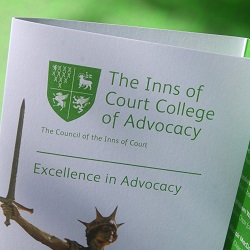There is a significant attainment gap between providers of the Bar training course, ranging from a pass rate of 94% at the highest to 49% at the lowest.
Students at the Inns of Court College of Advocacy (ICCA) were the most successful, followed by the University of Law’s Bristol, Leeds, Manchester and Nottingham branches (79%) and City Law School in London (78%).
The University of Law’s Birmingham and London branches lagged behind at 66%.
BPP’s branches Birmingham, Bristol and Leeds had the lowest pass rate of 49%, although BPP Manchester and London had 68% and 56% respectively.
The University of the West of England recorded a 51% pass rate, just behind Nottingham Trent University’s 53%, compared an average of 65% across all 10 institutions (operating from 21 sites) offering the course.
The new, more flexible vocational course replaced the Bar professional training course in September 2020, when the ICCA entered the market, along with the University of Hertfordshire.
The Bar Standards Board, which produced the figures, said it was “tempting to use league tables of exam results as the marker of quality” but in reality there were a range of factors that need to be considered, not least the extent to which a course provider “recruits diversely”.
The BSB showed how success was closely linked to degree results, with 84% of students with first-class degrees passing the course, 65% of those with 2:1s and only 39% of those with 2:2s.
However, City Law School bucked the trend, with two-thirds of its 2:2 students passing.
Half of successful students with first-class degrees went on to secure pupillages, as did about a quarter of those with 2:1s, although in both cases the figures were lower in the first year of the new course than the last year of the old one.
By contrast, although fewer than 10% of those with a 2:2 obtained pupillage, it was still significantly more than in previous years.
The University of Law in London was the only provider to see more than 25% of its 2:2 students secure pupillages.
In a report for this month’s BSB board meeting, the regulator said the new course “enabled greater flexibility within a range of permitted pathways” and were more affordable.
Implementation of the new course “saw a drop in the fees charged across the majority of providers” of around £3,000 in 2020/21 compared to 2019/20, or almost £4,000 after adjusting for inflation.
When weighting the average tuition fee with regard to the number of students at each provider, the BSB said the average student in 2019/20 would have paid around £18,700 in tuition fees when adjusted for inflation, compared to around £13,500 In 2020/21 and £14,000 in 2021/22.
This meant that prices for Bar training courses in London were now “more in line with those last seen around 2000/01 and are more in line with those seen around 2011/12 outside of London”.
The BSB said there were some “recurring narratives” in relation to the regulation of Bar training, one of which was that the providers recruited “too many students onto their courses that have no hope of passing the exams or obtaining pupillage”, in particular those with a 2:2 degree.
However, the BSB said it was “worth remembering” that Legal Services Board guidance said regulators should not “impose limits on numbers entering the profession either directly or indirectly”.
The BSB said its education and training committee had “noted that there was evidence to suggest that individuals from disadvantaged backgrounds underachieve at academic work and raising the entry requirement may entrench a disadvantage that might already be present”.
The most recent report on the legal practice course for solicitors also showed a big gap in performance between different institutions, ranging from a 100% pass rate to 31%, although the individual institutions were not named. The overall pass rate was 58%.















Leave a Comment